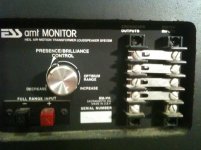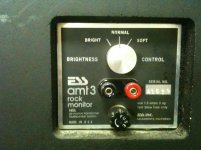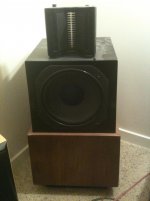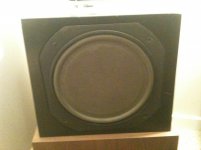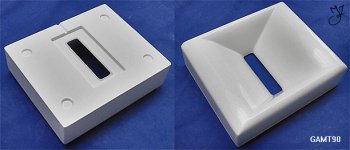Now to Part 2:
Here the author describes his construction of the Heil 300hz horn and an actual AMT driver (difficult)(most experimenters would rather work with an existing commercially manufactured AMT driver I would imagine)
Thank You New Vista - great information. I'm NOT tempted to construct the diaphragm portion of an AMT - but using one of the replacement diaphragms looks to have a chance.
BTW- I notice that you are new here and wish to extend you a warm Welcome to diyAudio!!!!! 😀😀😀
With old articles that one hanging around I suspect that you have been at this little hobby for awhile!! 😉
Last edited:
Heils / Fostex FE208ES-R / Hawthorne Audio Augies
Hello Badman.
I love what you're doing hornloading the Heils. I'm using a pair of large, dipole, Heils with Fostex FE208ES-R drivers in Sachiko cabinets and even though the FE208ES-R drivers are 98dB an the Heils are only 93dB I feel no need for more volume from them than I'm already getting. I run the FE208ES-R drivers fullrange and allow then to XO mechanically, which is 80Hz - 10Khz in the Sachiko cabinets.
The Heils are crossed in @ 8Khz and cover from 8Khz to 25Khz and blend seamlessly with the FE208ES-R drivers. Finally the bottom end is coverd by a pair of 15", dipole, Hawthrone Audio Augies, which are crossed in @ 160Hz and cover from 160Hz down to 25Hz, with an external XO, equalization and pro solidstate power amp. The sound is jaw-dropping it's so clean, harmonically right with correct timbre and pitch. I can easily hit 110dB peaks without the slightest hint of distortion or strain.
That said, I love what you're doing and it's given me some ideas. I just want to warn you to be careful not attempt to use the Heils to low in frequency ---{I use mine only from 8Khz and above}--- I know ESS says they can be crossed over at 800Hz, but they're completely wrong. Perhaps this email I received from Dr Albert Von Schweikert will shed some light on this issue...
=========================================================
Dear Tom,
I was Dr. Heil’s personal assistant for the last two years of his career and developed the first three-way AMT system, which hit the market just before Oskar died in an auto accident. His wife closed the company, so my design was never sold in large quantities, I believe there were less than 100 units sold in the 3 months it was on the market.
The Heil driver requires a 24dB/octave crossover at 1.2kHz or it will go into distortion. The Excel magnesium drivers are fantastic and can be crossed over at 1.2kHz with 24dB/oct as well, use a line source of the 6.5” units. I would use an active crossover, a passive crossover would be difficult for you to design unless you had access to test equipment and have extensive experience with circuit design.
Best regards,
Albert Von Schweikert
CEO/Chief Design Engineer
Von Schweikert Audio
Temecula, California , USA
Phone (951) 308-6463
FAX (951) 308-6469
Web: HigherFi - Worlds Best Audio Hifi Audio | von From HigherFi
=========================================================
So as you see Dr Von Schweikert said they distort below 1.2Khz an vn then need a 24dB XO to keep the signal clean ---{perhaps that explains the 1Khz hump someone noticed}--- The Heils have the very best highs I've ever heard and I've owned or own TAD 2001, Jensen RP 302 & Pioneer HW-7, which arn't as well known as the previous two, but are every bit as good "if" not better! I'll be keeping an eyes on this thread to see how your hornloading of the large Heils works out, because I really like the idea. You've definitely got me thinking!
Tom Scata (thetubeguy1954)
"The man that hath no music in himself nor is not moved with concord of sweet sounds is fit for treasons, stratagems and spoils."
- William Shakespeare
An externally hosted image should be here but it was not working when we last tested it.
Hello Badman.
I love what you're doing hornloading the Heils. I'm using a pair of large, dipole, Heils with Fostex FE208ES-R drivers in Sachiko cabinets and even though the FE208ES-R drivers are 98dB an the Heils are only 93dB I feel no need for more volume from them than I'm already getting. I run the FE208ES-R drivers fullrange and allow then to XO mechanically, which is 80Hz - 10Khz in the Sachiko cabinets.
The Heils are crossed in @ 8Khz and cover from 8Khz to 25Khz and blend seamlessly with the FE208ES-R drivers. Finally the bottom end is coverd by a pair of 15", dipole, Hawthrone Audio Augies, which are crossed in @ 160Hz and cover from 160Hz down to 25Hz, with an external XO, equalization and pro solidstate power amp. The sound is jaw-dropping it's so clean, harmonically right with correct timbre and pitch. I can easily hit 110dB peaks without the slightest hint of distortion or strain.
That said, I love what you're doing and it's given me some ideas. I just want to warn you to be careful not attempt to use the Heils to low in frequency ---{I use mine only from 8Khz and above}--- I know ESS says they can be crossed over at 800Hz, but they're completely wrong. Perhaps this email I received from Dr Albert Von Schweikert will shed some light on this issue...
=========================================================
Dear Tom,
I was Dr. Heil’s personal assistant for the last two years of his career and developed the first three-way AMT system, which hit the market just before Oskar died in an auto accident. His wife closed the company, so my design was never sold in large quantities, I believe there were less than 100 units sold in the 3 months it was on the market.
The Heil driver requires a 24dB/octave crossover at 1.2kHz or it will go into distortion. The Excel magnesium drivers are fantastic and can be crossed over at 1.2kHz with 24dB/oct as well, use a line source of the 6.5” units. I would use an active crossover, a passive crossover would be difficult for you to design unless you had access to test equipment and have extensive experience with circuit design.
Best regards,
Albert Von Schweikert
CEO/Chief Design Engineer
Von Schweikert Audio
Temecula, California , USA
Phone (951) 308-6463
FAX (951) 308-6469
Web: HigherFi - Worlds Best Audio Hifi Audio | von From HigherFi
=========================================================
So as you see Dr Von Schweikert said they distort below 1.2Khz an vn then need a 24dB XO to keep the signal clean ---{perhaps that explains the 1Khz hump someone noticed}--- The Heils have the very best highs I've ever heard and I've owned or own TAD 2001, Jensen RP 302 & Pioneer HW-7, which arn't as well known as the previous two, but are every bit as good "if" not better! I'll be keeping an eyes on this thread to see how your hornloading of the large Heils works out, because I really like the idea. You've definitely got me thinking!
Tom Scata (thetubeguy1954)
"The man that hath no music in himself nor is not moved with concord of sweet sounds is fit for treasons, stratagems and spoils."
- William Shakespeare
I've been talking about prototypes today with Autotech. I think before Christmas first prototypes should be available. We are waiting for some parts needed - this is a modular system.
Hi jzagaja
just wondering if there is an update on your waveguide ( GAMT90 ) that could fit the beyma tpl150?
photos, measurements,availabilty, prices would all be much appreciated .
thanks
An externally hosted image should be here but it was not working when we last tested it.
Hello Badman.
I love what you're doing hornloading the Heils. I'm using a pair of large, dipole, Heils with Fostex FE208ES-R drivers in Sachiko cabinets and even though the FE208ES-R drivers are 98dB an the Heils are only 93dB I feel no need for more volume from them than I'm already getting. I run the FE208ES-R drivers fullrange and allow then to XO mechanically, which is 80Hz - 10Khz in the Sachiko cabinets.
The Heils are crossed in @ 8Khz and cover from 8Khz to 25Khz and blend seamlessly with the FE208ES-R drivers. Finally the bottom end is coverd by a pair of 15", dipole, Hawthrone Audio Augies, which are crossed in @ 160Hz and cover from 160Hz down to 25Hz, with an external XO, equalization and pro solidstate power amp. The sound is jaw-dropping it's so clean, harmonically right with correct timbre and pitch. I can easily hit 110dB peaks without the slightest hint of distortion or strain.
That said, I love what you're doing and it's given me some ideas. I just want to warn you to be careful not attempt to use the Heils to low in frequency ---{I use mine only from 8Khz and above}--- I know ESS says they can be crossed over at 800Hz, but they're completely wrong. Perhaps this email I received from Dr Albert Von Schweikert will shed some light on this issue...
=========================================================
Dear Tom,
I was Dr. Heil’s personal assistant for the last two years of his career and developed the first three-way AMT system, which hit the market just before Oskar died in an auto accident. His wife closed the company, so my design was never sold in large quantities, I believe there were less than 100 units sold in the 3 months it was on the market.
The Heil driver requires a 24dB/octave crossover at 1.2kHz or it will go into distortion. The Excel magnesium drivers are fantastic and can be crossed over at 1.2kHz with 24dB/oct as well, use a line source of the 6.5” units. I would use an active crossover, a passive crossover would be difficult for you to design unless you had access to test equipment and have extensive experience with circuit design.
Best regards,
Albert Von Schweikert
CEO/Chief Design Engineer
Von Schweikert Audio
Temecula, California , USA
Phone (951) 308-6463
FAX (951) 308-6469
Web: HigherFi - Worlds Best Audio Hifi Audio | von From HigherFi
=========================================================
So as you see Dr Von Schweikert said they distort below 1.2Khz an vn then need a 24dB XO to keep the signal clean ---{perhaps that explains the 1Khz hump someone noticed}--- The Heils have the very best highs I've ever heard and I've owned or own TAD 2001, Jensen RP 302 & Pioneer HW-7, which arn't as well known as the previous two, but are every bit as good "if" not better! I'll be keeping an eyes on this thread to see how your hornloading of the large Heils works out, because I really like the idea. You've definitely got me thinking!
Tom Scata (thetubeguy1954)
"The man that hath no music in himself nor is not moved with concord of sweet sounds is fit for treasons, stratagems and spoils."
- William Shakespeare
Hi, quickly, what 3 way Heil speaker was Dr Von Schweikert talking about in that letter to you? And what are the Excel magnesium drivers he is referring to? thank you...
Hi, quickly, what 3 way Heil speaker was Dr Von Schweikert talking about in that letter to you? And what are the Excel magnesium drivers he is referring to? thank you...
Hello Joshua!
I believe that due to the fact that less than 100 units sold ---{would 100 units equal 50 pairs}--- and they were on the market approx 3 months, these 3-way speakers Dr Von Schweikert was refering to have vanished from the annals of audio history. I did some researching and was unable to discover anything about these speakers! So I'd suggest either calling Dr Von Schweikert directly at (951) 308-6463 or emailing him at albert@vonschweikert.com and asking him about these speakers...
I never asked Dr Von Schweikert which magnesium driver he was speaking of specifically, but from what he said it should be fairly easy to fiqure out which driver(s) he meant. First I know that SEAS has three lines of drivers called Prestige, Excel & Exotic and SEAS also sells magnesium drivers. So I believe it's safe to assume Dr Von Schweikert most likely was refering to the SEAS 6.5" EXCEL magnesium drivers.
So if that's the case ---{and I believe it is}--- that leaves us to examine which 6.5" Excel magnesium drivers SEAS has available. When I checked on the internet I found SEAS has two 6.5" magnesium drivers in their Excel line. One is the W18EX001 and the other one is the W18E001! Clicking on either model will display their specs. From what I can see, the main difference is their QTS. Which is 0.26 for the W18EX001 and 0.42 for the W18E001.
Thus your choice of which 6.5" magnesium driver to use with the Heils would mainly be dictated by the type of enclosure you'd want to use with your Heil/SEAS driver combination. However unless you use a line source of these SEAS drivers you'll have to really attenuate the Heil driver s considerably because the Heil's sensitivity rating is 93dB ---{at least with my vintage Heils that is}--- but the Excel drivers are 86db & 88db which is considerable less senstive than the Heils.
Take your time, do some research and don't be afraid to ask questions ---{unless of course you're an experienced speaker builder}--- and you'll end up with a great set of speakers. Without trying to sound like I'm boasting, I can tell you the Heil/Fostex FE208ES-R combo is such a wonderful a match sonically, friends from the SETriodes Group, Central Florida Audio Society & Space Coast Audio Society have refered to the sound of the Sachiko Reference I ---{which is what I call my speakers}--- "World-Class" & "Reference-Level" which tells you just how good the Heils reproduce music even by today's standards. The Heils were way ahead of their time and IMHO as good as any tweeter out there today. I'm looking for my 4th pair as I write this.
Good luck Joshua, I hope you'll end up with an audio system or new component that's wildly beyond what your expectations were for it sonically when you fire it up the first time...
Thetubeguy1954 (Tom Scata)
Tom,Hello Joshua!
I believe that due to the fact that less than 100 units sold ---{would 100 units equal 50 pairs}--- and they were on the market approx 3 months, these 3-way speakers Dr Von Schweikert was refering to have vanished from the annals of audio history. I did some researching and was unable to discover anything about these speakers! So I'd suggest either calling Dr Von Schweikert directly at (951) 308-6463 or emailing him at albert@vonschweikert.com and asking him about these speakers...
I never asked Dr Von Schweikert which magnesium driver he was speaking of specifically, but from what he said it should be fairly easy to fiqure out which driver(s) he meant. First I know that SEAS has three lines of drivers called Prestige, Excel & Exotic and SEAS also sells magnesium drivers. So I believe it's safe to assume Dr Von Schweikert most likely was refering to the SEAS 6.5" EXCEL magnesium drivers.
So if that's the case ---{and I believe it is}--- that leaves us to examine which 6.5" Excel magnesium drivers SEAS has available. When I checked on the internet I found SEAS has two 6.5" magnesium drivers in their Excel line. One is the W18EX001 and the other one is the W18E001! Clicking on either model will display their specs. From what I can see, the main difference is their QTS. Which is 0.26 for the W18EX001 and 0.42 for the W18E001.
Thus your choice of which 6.5" magnesium driver to use with the Heils would mainly be dictated by the type of enclosure you'd want to use with your Heil/SEAS driver combination. However unless you use a line source of these SEAS drivers you'll have to really attenuate the Heil driver s considerably because the Heil's sensitivity rating is 93dB ---{at least with my vintage Heils that is}--- but the Excel drivers are 86db & 88db which is considerable less senstive than the Heils.
Take your time, do some research and don't be afraid to ask questions ---{unless of course you're an experienced speaker builder}--- and you'll end up with a great set of speakers. Without trying to sound like I'm boasting, I can tell you the Heil/Fostex FE208ES-R combo is such a wonderful a match sonically, friends from the SETriodes Group, Central Florida Audio Society & Space Coast Audio Society have refered to the sound of the Sachiko Reference I ---{which is what I call my speakers}--- "World-Class" & "Reference-Level" which tells you just how good the Heils reproduce music even by today's standards. The Heils were way ahead of their time and IMHO as good as any tweeter out there today. I'm looking for my 4th pair as I write this.
Good luck Joshua, I hope you'll end up with an audio system or new component that's wildly beyond what your expectations were for it sonically when you fire it up the first time...
Thetubeguy1954 (Tom Scata)
Thank you for the thorough reply!!!! I posted questions here many moons ago when I first started to "rebuild" speakers….. my first project was just refoaming the surrounds on the AMT3 rock monitors…… the refoaming led to replacing the original capacitors and the resistors to the best of my ability because I noticed that the insides had already ben changed in one of the cabinets…… I learned about soldering and wire gauge and the beautiful frustration of this hobby…such as having to do everything inside the cabinet because the crossover won't come out without being destroyed…..and I learned that I must know some yoga because i was able to contort into some wonderful positions while doing this!
After all of that…… When I compared the speakers that I was so damn proud of building to my purchased ones (Dali Euphonia MS5) I was disappointed….
The high end was actually better for the ESS, but there was a missing midrange punch….. and the low end is not tight or low enough…….
But, there is something about the high end… something magical so clear and true to life….but the rest of the speaker just falls so far short….
I thought that making it better would just be to simply replace the woofers with new ones, but it is so much more complicated than that…… So i have been reading and reading and trying to learn… but with a 18 month old boy and a 8 week old daughter the "projects" and hobby is quickly disappearing…. but my desire has not……
I have the AMT Monitor and the AMT3 Rock Monitor, I also have the AMT II and a newly purchased AMT Tower…… So I obviously love the sound…. I just want to know how to make it better….
My quest started when I was looking for my first speakers after making some money… I went around and around Los Angeles listening and trying to learn what I liked…. I found a lot of very pompous people… and some very humble people (who I tended to go back to)… I first learned about the Heil driver from this man What?s New | Paul Squillo Music Systems
and I was smitten, but I did not buy his speakers because I knew nothing about speakers and now am stuck with a brand that has no name recognition in the US. Rather than eat the whole thing I listen happily to them because they are pleasing and better than the ESS speakers in terms of mids and bass… but I still wonder if I can make the ESS speakers sound better….and or equivalent to my professionally made speakers….. here are some pics of the speakers…..
Attachments
…..and I learned that I must know some yoga because i was able to contort into some wonderful positions while doing this!
...
LOL
AMT speaker blend well with OB speakers - but - you will *also* have to learn about XO design - having mastered yoga, no problem for you ...
😉
Michael
this was the speaker i heard that introduced me to the folded ribbon..... and it is horn loaded as well so not too off topic!! 🙂
http://www.jpslabs.com/ces2001/ces2001.htm
http://www.jpslabs.com/ces2001/ces2001.htm
Last edited:
ess heils 1a m
hello
i have my orginal . ess 1a m 1975. that i just recaped with some big solens.
they sound better. when i bi-amp i have 2set of ess electronic x overs model 2241. the one from
1975 was set up for 800hz the newer one 1998 was set at 1000hz.
they sound much better bi- amped. these do not have 6" midrange.
audioray boston
hello
i have my orginal . ess 1a m 1975. that i just recaped with some big solens.
they sound better. when i bi-amp i have 2set of ess electronic x overs model 2241. the one from
1975 was set up for 800hz the newer one 1998 was set at 1000hz.
they sound much better bi- amped. these do not have 6" midrange.
audioray boston
something new?
I found something very interesting online tonight…..
ESS Heil Air Motion drivers - eBay (item 230583370829 end time Feb-17-11 21:33:03 PST)
It looks like a promising horn loaded design.
Joshua
I found something very interesting online tonight…..
ESS Heil Air Motion drivers - eBay (item 230583370829 end time Feb-17-11 21:33:03 PST)
It looks like a promising horn loaded design.
Joshua
Not a Heil, and they call it an Acoustic Lens not a horn...................just adding to the mix for context.
SoundLAB's MiniStat
Sound Lab MiniStat - an electrostatic surround speaker
Mini-Stats! - Sound Lab Owners Forum
SoundLAB's MiniStat
Sound Lab MiniStat - an electrostatic surround speaker
An externally hosted image should be here but it was not working when we last tested it.
The MiniStat is a remarkable miniature high-end quality speaker. The MiniStat is intended for use in music systems as well as small scale home theater systems. Two electrostatic panels are used to reproduce mid and high frequencies with unsurpassed clarity and purity. Furthermore, a high performance bass driver is used along with slotted port technology. The performance of the MiniStat is truly astonishing. Efficiency is high, requiring only a few watts to achieve concert level sound.
A unique acoustical lens is used in the MiniStat to disperse the mid and high frequencies over an angle that’s wider than the raw driver’s natural angle of dispersion. This lens works on the same refractive principle as optical lenses. In both optical and acoustical applications a precision lens is used to bend the rays of energy flow to a pre-determined angle. In the case of the MiniStat, the natural dispersion angle of the raw electrostatic panel is only 15 degrees at 20KHz. The acoustical lens increases this angle to 90 degrees.
The lens does not create any coloration or other anomalies in the sound. It is designed to provide properly balanced full spectrum sound over a horizontal angle of 90 degrees. The result of this technology is that the entire listening room becomes the "sweet spot".
Specifications
Frequency response 60 Hz to ultrasonics
Audio power (min/max) 10/150 watts (music power)
Sensitivity 94 dB/1W/1m
Panel radiating area 50 square inches
Low freq. driver 6.5" diameter - enclosure is slot-ported
Crossover frequency 950 Hz
Horizontal dispersion 90 degrees (full spectrum)
Vertical dispersion 40 degrees
Impedance (nominal) 8 ohms
Bias Power Supply 117/230 VAC, 50/60 Hz, 2 watts
Controls
High frequency
D.C. Bias
4 positions in 3dB steps
Continuously adjustable
Height x Width x Depth 20" x 9" x 12"
Weight (per speaker) 32 pounds
Finishes Medium oak is standard
(other finishes available)
Mini-Stats! - Sound Lab Owners Forum
The Mini-Stat looks like 2/3 of a Marquis. It uses two of the same electrostatic panels instead of three, and uses a single 6.5" aluminum cone woofer in a vented enclosure. The electrostatic panels are stacked one above the other, splayed slightly to improve vertical dispersion. For wider horizontal dispersion, the speaker can be placed on its side.
Last edited:
Hi jzagaja
just what i was waiting for.
any data on how they perform on beyma tpl150?
what are the dimensions of these ?
what is the price?
just what i was waiting for.
any data on how they perform on beyma tpl150?
what are the dimensions of these ?
what is the price?
I'll get samples on 12-FEB and perform measurements with Harwood AM35. I don't have Beyma TPL150. It's labor extensive waveguide.
Not a Heil, and they call it an Acoustic Lens not a horn...................just adding to the mix for context.
http://www.diyaudio.com/forums/multi-way/161627-horn-honk-wanted-16.html#post2391121
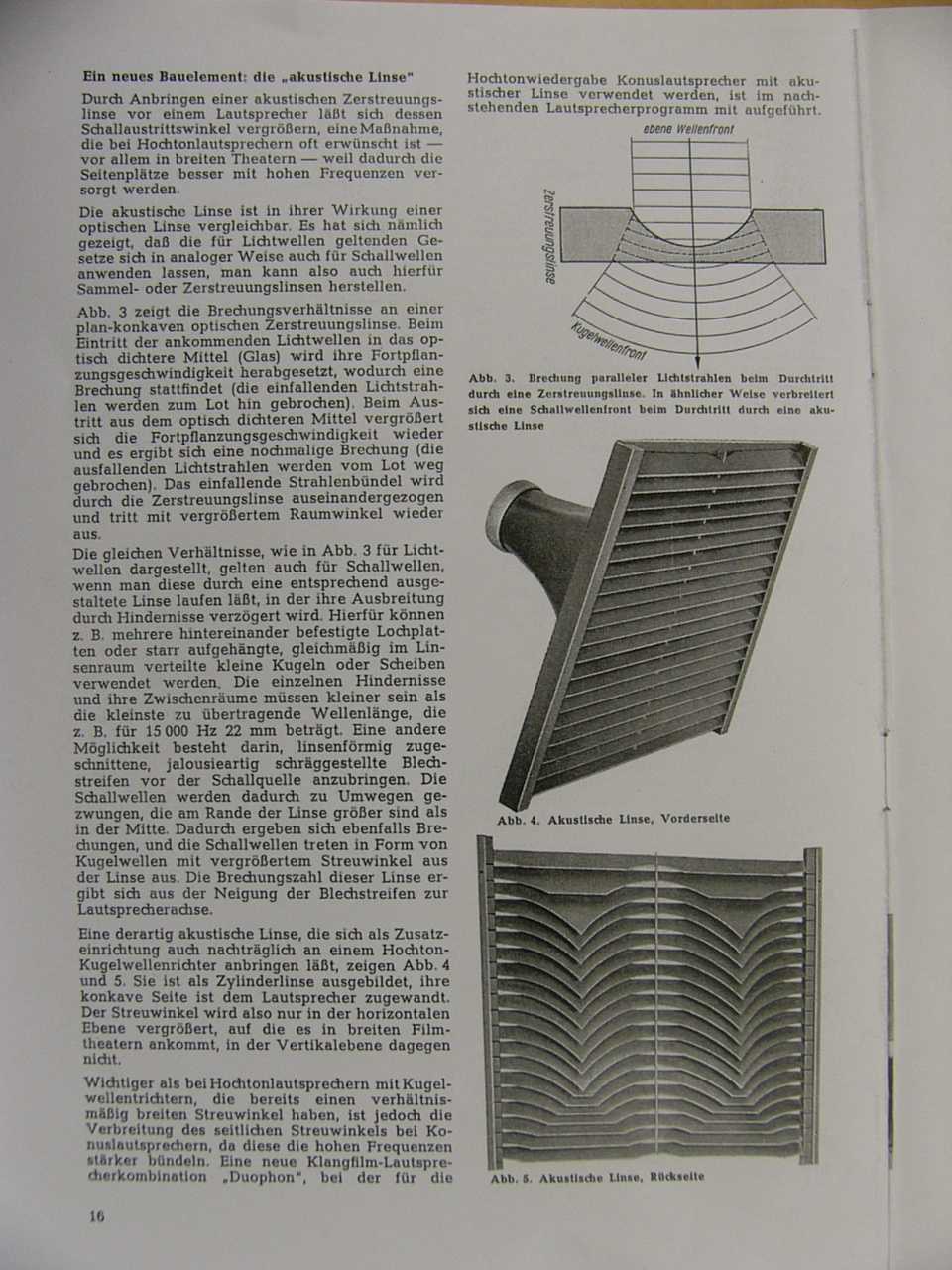
😉
Michael
I'll get samples on 12-FEB and perform measurements with Harwood AM35. I don't have Beyma TPL150. It's labor extensive waveguide.
If you send over a sample, I'll do the measurements with the TPL150 for you - if you like
Michael
Michael ,
i would really like to see your measurements and evaluation of the beyma with jzagaja's dipole horn.
do you know any other AMT drivers that are similar or better then the Beyma ?
do you have a recommendation for a driver that can mates well w/ the beyma in a dipole configuration?
i am considering using the Neo10.
i would really like to see your measurements and evaluation of the beyma with jzagaja's dipole horn.
do you know any other AMT drivers that are similar or better then the Beyma ?
do you have a recommendation for a driver that can mates well w/ the beyma in a dipole configuration?
i am considering using the Neo10.
Haven't experimented with the NEO10 but extrapolating from the NEO 3 the AMT is quite a different league.
Sadly there are not that many manufacturers of modern AMT - and they all are expensive.
You could go for the Mundorf too - which currently is probably the most sophisticated built but also the most expensive.
http://www.diyaudio.com/forums/planars-exotics/157372-amt-new-player-game.html
regarding further measurements we have to wait until Jzagaja has samples available
Michael
Sadly there are not that many manufacturers of modern AMT - and they all are expensive.
You could go for the Mundorf too - which currently is probably the most sophisticated built but also the most expensive.
http://www.diyaudio.com/forums/planars-exotics/157372-amt-new-player-game.html
regarding further measurements we have to wait until Jzagaja has samples available
Michael
- Status
- Not open for further replies.
- Home
- Loudspeakers
- Planars & Exotics
- Hornloading the Heil AMT1

